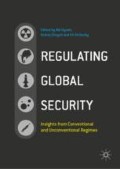Abstract
The governance of natural uranium, specifically the production and trade of uranium ore concentrates (UOC), generally referred to as ‘yellowcake’, has historically been subjected to limited international controls. Over the past two decades, however, an evolving structure of international nuclear treaties has grown to include a range of security applications such as the 1987 Convention on the Physical Protection of Nuclear Materials (CPPNM) and its 2005 Amendment, UN Security Council Resolution 1540 of 2004, and the 2005 International Convention for the Suppression of Nuclear Acts of Terrorism (ICSANT). The provisions in these international legal instruments extend to the protection of UOC in international transport, as well as in domestic use, storage and transport. At the same time, the application of safeguards has been extending upstream in the nuclear fuel cycle, capturing materials in process at conversion facilities and potentially the product at mills, with reporting obligations covering uranium mines and concentration plants. Moreover, the geographies of supply and demand are shifting, creating new trade routes, actors and costs; how to build national uranium regulatory systems from scratch; and the application of current export controls to countries outside the Nuclear Non-proliferation Treaty (NPT). This chapter looks to materials at the very front end of the nuclear fuel cycle and the evolving complex patchwork of national and international instruments governing their protection and trade. This patchwork rests within the larger global architecture—and the global power structure—of nuclear materials governance. It exemplifies how the three rules of real estate (location, location, location) apply to uranium, representing the mixed nature of formalised and informal mechanisms at the international level and their wide-ranging applications at the national level.
Access this chapter
Tax calculation will be finalised at checkout
Purchases are for personal use only
References
Abbott, K., Keohane, R., Moravcsik, A., Slaughter, A., & Snidal, D. (2000). The Concept of Legalization. International Organization, 54(3), 401–419.
ASTM International. Standard Specification for Nuclear-Grade Uranyl Nitrate Solution, Designation C-788-98 (Reapproved as C-788-03 in 2003).
ASTM International. Standard Specification for Nuclear-Grade, Sinterable Uranium Dioxide Powder, Designation C753-04 (Reapproved 2009).
Cooley, J. N. (2001). Integrated Safeguards—Current Status of Development and Plans for Implementation, IAEA-SM-367/3/01. https://www-pub.iaea.org/MTCD/publications/PDF/ss-2001/PDF%20files/Session%203/Paper%203-01.pdf.
Deitelhoff, N., & Zimmermann, L. (2013). Things We Lost in the Fire: How Different Types of Contestation Affect the Validity of International Norms (PRIF Working Papers 18). Frankfurt am Main: Hessische Stiftung Friedens- und Konfliktforschung. http://nbn-resolving.de/urn:nbn:de:0168-ssoar-455201.
Everton, C., Bayer, S., & Carlson, J. (2010). Developments in the IAEA’s Nuclear Security Series and Physical Protection Guidance Document INFCIRC/225. Paper Presented to the Annual Meeting of the Institute of Nuclear Materials Management, Baltimore, Maryland, 11–15 July 2010.
Harries, M. (2015). Disarmament as Politics: Lessons from the Negotiation of NPT Article VI (Chatham House Research Paper).
Hirsch, T. (2004). The Additional Protocol: What It Is and Why It Matters. The Nonproliferation Review (Fall–Winter), 143–144.
IAEA. (1972, June 1). The Structure and Content of Agreements Between the Agency and States Required in Connection with the Treaty on the Non-proliferation of Nuclear Weapons, INFCIRC/153 (Corrected).
IAEA. (2002, March 18). Background on IAEA Board of Governors’ Approval of Framework for Integrated Safeguards.
IAEA Board of Governors. (2003a, June 6). GOV/2003/40.
IAEA Department of Safeguards. (2003b, October 1). Policy Paper 18: Safeguards Measures Applicable in Conversion Plants Processing Natural Uranium. SMR 2.18.
IAEA. (2006, August 16). Report by the Director General, Board of Governors, GOV/2006/46-GC(50)/13. Nuclear Security—Measures to Protect Against Nuclear Terrorism. http://www.iaea.org/About/Policy/GC/GC50/GC50Documents/English/gc50-13_en.pdf.
IAEA. (2013). Determination of Uranium Bearing Materials Meeting the Conditions of Paragraph 34(c) of INFCIRC/153 (corrected) (Policy Paper 21). SG-PL-12684.
IAEA. (2016, April). Nuclear Security for the Uranium Extraction Industry, IAEA-TDL-003.
IAEA. (2017). Safeguards Statement for 2016. https://www.iaea.org/sites/default/files/statement_sir_2016.pdf.
IAEA. (2018). Status of the Additional Protocol. https://www.iaea.org/topics/additional-protocol/status. Accessed 16 November 2018.
International Nuclear Safety Group, INSAG-24. (2010). The Interface Between Safety & Security at Nuclear Power Plants, Vienna. http://wwwpub.iaea.org/MTCD/publications/PDF/Pub1472_web.pdf.
Keohane, R. O. (1989). Neoliberal Institutionalism: A Perspective on World Politics. In R. Keohane (Ed.), International Institutions and State Power: Essays in International Relations Theory (pp. 1–20). Boulder: Westview Press.
Vestergaard, C. (2015a, October). Safeguarding the Front-End of the Nuclear Fuel Cycle. Trust & Verify (pp. 1–4), July–September 2015.
Vestergaard, C. (2015b). Governing Uranium Globally. DIIS Report, 2015, 09.
Vestergaard, C. (2018). Capturing the Starting Point: Evolving Nuclear Safeguards and the Front End of the Nuclear Fuel Cycle. Report published by the Stimson Center.
Vestergaard, C., & Hastings, J. (Forthcoming, 2019). Safeguards and Security at the (Very) Front End of the Nuclear Fuel Cycle. The Nonproliferation Review.
Williams, J., & Wolfsthal, J. (2005). The NPT at 35: A Crisis of Compliance or a Crisis of Confidence? (pp. 1–6) UNA-USA No. 7.
Author information
Authors and Affiliations
Corresponding author
Editor information
Editors and Affiliations
Rights and permissions
Copyright information
© 2019 The Author(s)
About this chapter
Cite this chapter
Vestergaard, C. (2019). Global Governance of Natural Uranium: An Uneven Patchwork. In: Hynek, N., Ditrych, O., Stritecky, V. (eds) Regulating Global Security . Palgrave Macmillan, Cham. https://doi.org/10.1007/978-3-319-98599-2_5
Download citation
DOI: https://doi.org/10.1007/978-3-319-98599-2_5
Published:
Publisher Name: Palgrave Macmillan, Cham
Print ISBN: 978-3-319-98598-5
Online ISBN: 978-3-319-98599-2
eBook Packages: Political Science and International StudiesPolitical Science and International Studies (R0)

